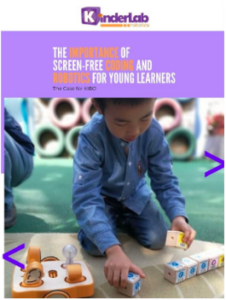National Girls Collaborative: Girls in Robotics- Empowering Girls Early to Support Long-Term Equity
Dr. Amanda Sullivan, a researcher who contributed to the development of the KIBO screen-free robot, shares this blog about empowering young girls interest in STEM. The articles reads in part:
“As a researcher and educator who focuses on edtech and early childhood development, I firmly believe that positive early experiences with STEM are important. Young children in preschool and early elementary school are naturally curious about the world around them. This is the perfect time to teach them about their human-engineered environment and pique their interest in STEM fields like robotics and coding. My research has demonstrated that children as young as 3-years-old can successfully build and program simple robots while learning foundational engineering and robotics concepts in the process. Robotics kits also allow children to develop fine motor skills and hand-eye coordination while also engaging in collaboration and discussion with peers. My past research has even shown that programming robots can significantly increase children’s sequencing ability (i.e., the ability to put events or actions in the right order), a foundational pre-math and pre-literacy skill. All these experiences may be especially crucial for girls who typically get less experience with building, coding, and tinkering in their childhoods than boys. Research conducted by the LEGO Group and the Geena Davis Institute on Gender in Media in 2021 indicated that parents still more frequently encourage sons to do STEM activities, including using STEM-themed toys, than daughters.
It is critical to reach young girls during their foundational early childhood years to counter (or better yet, prevent) stereotypes and encourage equal opportunities to pursue STEM (learn more in my book Breaking the STEM Stereotype: Reaching Girls in Early Childhood). Basic stereotypes begin to develop in children around 2 to 3 years of age. As children grow older, stereotypes about sports, occupations, and adult roles expand, and their gender associations become more sophisticated. Negative stereotypes toward math and science can develop in girls starting in elementary school. Recent research has shown that stereotypes about girls’ interest in computer science and engineering are formed as early as age 6 and are evident across multiple ages from childhood through adolescence.
During my doctoral studies with the DevTech Research Group, I wanted to help create engineering and coding tools that were fun and playful for all young children, while also holding a special potential to reach girls. I worked on the development of the KIBO Robotics Kit, a screen-free and gender-neutral robotics kit designed for young learners in pre-k through early elementary school. In my research during that time, I found that implementing a KIBO robotics curriculum that focused on collaboration and helping (students created “Helpful Robots” to improve their school community) was an effective way to increase early elementary girls’ interest in engineering. In the years that followed, I also found that integrating the arts, literature, music, and movement with robotics had the potential to reach many young children who did not already identify with STEM.”
Amanda offers three ways you can encourage girls to take part in STEM
Whether you are an educator, caregiver, parent, or connect with youth in some other capacity, you have the power to counter stereotypes and inspire girls in STEM. Here are three ways to get started:
- Introduce Hands-On Coding and Engineering Early – Don’t wait to expose girls to coding and engineering! Robotics kits designed for young learners are the perfect introduction to building, design, coding, and more (get some ideas for specific products here). For no or low-cost options, consider exploring unplugged activities to explore computer science, reading picture books that introduce engineering and coding concepts, and using free coding apps for young children like ScratchJr. Find free curriculum and other research-based resources here.
- Expose Girls to Role Models – Introducing girls to role models through books, media, in-person and online experiences can help break stereotypes about who can and should pursue STEM. Find role modeling and mentoring resources here. Find a list of notable women in robotics (updated annually) here.
- Foster a Growth Mindset – Personal views about intelligence and failure can impact girls’ achievement and long-term persistence in rigorous STEM fields. Encouraging a “growth mindset” in girls or the belief that intelligence is not fixed, but instead can change and grow incrementally through practice and hard work, can help counter the stereotype that some people are just “naturally” gifted at math and science. You can simplify this concept by telling young children the brain is like a muscle that can get stronger with more hard work and practice.
Read the full article.



















